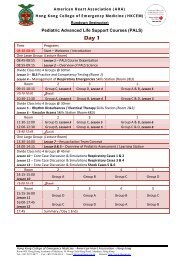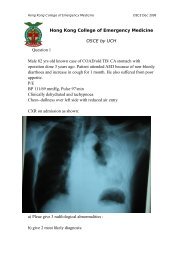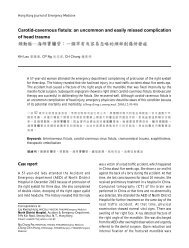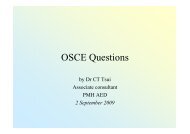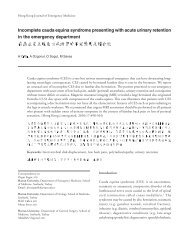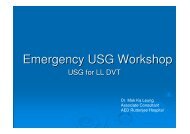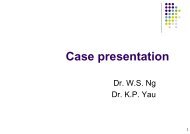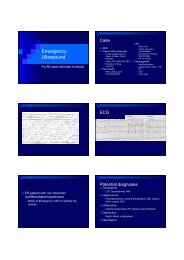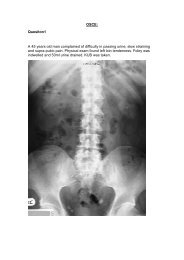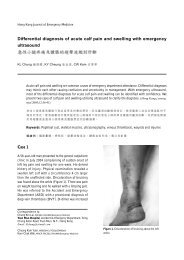OSCE - Hong Kong College of Emergency Medicine
OSCE - Hong Kong College of Emergency Medicine
OSCE - Hong Kong College of Emergency Medicine
You also want an ePaper? Increase the reach of your titles
YUMPU automatically turns print PDFs into web optimized ePapers that Google loves.
Joint Clinical Meeting<br />
and Didactic Lectures<br />
<strong>OSCE</strong><br />
By<br />
UCH AED<br />
2-1-20082008
Case 1<br />
What device is showed on the CXR?
Case 1<br />
a)What device is showed on the CXR? (1 Mark)<br />
b)What kind <strong>of</strong> disease may need that device?<br />
(1 Mark)<br />
c)What do you need to do to perform an ECG for this<br />
unconscious patient? (1 Mark)<br />
d)If the patient needs defibrillation, what precautions<br />
will be needed? (2 Marks)
Case 2<br />
67 F consulted an alternative medicine<br />
practitioner ( 氣 功 師 ) for general malaise and<br />
low body weight<br />
She was advised to take a cooked grass carp<br />
gallbladder ( 鯇 魚 膽 )<br />
She developed nausea and epigastric pain 2 hrs<br />
after ingestion
Photos <strong>of</strong> the grass carp and the<br />
grass carp gallbladder
Changes <strong>of</strong> alanine aminotransferase (ALT),<br />
alkaline phosphatase (ALP), bilirubin and<br />
creatinine <strong>of</strong> the patient<br />
IU/L<br />
8000<br />
7000<br />
6000<br />
5000<br />
4000<br />
3000<br />
Day 5<br />
900<br />
800<br />
700<br />
600<br />
500<br />
400<br />
300<br />
umol/L<br />
ALT (IU/L)<br />
ALP (IU/L)<br />
Bilirubin (umol/L)<br />
Creatinine (umol/L)<br />
2000<br />
200<br />
1000<br />
100<br />
0<br />
0<br />
0 5 10 15 20 25 30<br />
days
Case 2<br />
a)What is the toxin involved ?(0.5 Mark)<br />
b)What are the typical features <strong>of</strong> poisoning ?<br />
(3 Marks)<br />
c)Please suggest a specific treatment. (0.5 Mark)<br />
d)Is chronic renal failure a typical feature ?<br />
(1 Mark)
Case 3<br />
A 45 years old lady presented with syncope<br />
while on the way to work with loss <strong>of</strong><br />
consciousness and some seizure activity noted<br />
lasting for 1 min.<br />
On arrival to AED, patient already regained<br />
consciousness. An ECG was performed and<br />
shown as follow.
Case 3 ECG
Case 3<br />
a)What is the diagnosis ? (1 Mark)<br />
b)Name 3 possible underlying causes. (3 Marks)<br />
c)What type <strong>of</strong> cardiac arrhythmia is the patient<br />
prone to ? (1 Mark)
Case 4<br />
A 58-year old gentleman, back seat passenger <strong>of</strong> a<br />
private car, was brought to AED after the vehicle was<br />
hit head on by a bus.<br />
On arrival, his vital signs were:<br />
GCS 15/15. BP 142/78 mmHg, Pulse 68 bpm, , RR<br />
16/min, SpO2 100% on 2 L oxygen supplement.<br />
On examination, chest air entry was equal and good.<br />
There was tenderness and guarding over the abdomen.
Case 4 Patient’s s clinical photo<br />
©Charles<br />
Gomersall August 2007
Case 4<br />
a)Name the sign on this photo. (1 Mark)<br />
b)Name 4 possible injuries in this gentleman?<br />
(2 Marks)<br />
FAST performed in the AED was negative.<br />
X-rays cervical spine, chest and pelvis were all<br />
normal.<br />
c)What further investigation(s) ) would you like to<br />
order? (1 Mark)
Case 4<br />
His BP dropped to 96/45 mmHg and pulse to<br />
105 bpm even with IV fluid bolus while waiting<br />
for further investigations.<br />
d)What is your further action?(1 Mark)
Case 5<br />
A 48 years old chronic hypnotic user presented<br />
with drowsiness after taking about 100 tablets <strong>of</strong><br />
“ 白 瓜 子 ” 2 hours ago.<br />
Her initial vital signs were as follow:<br />
GCS 9/15 (E3V1M5), pupils 2mm ERL, BP<br />
88/59 pulse 67/min, Sp O2 88% in room air.<br />
She was noticed to have shortness <strong>of</strong> breath and<br />
central cyanosis.
Case 5<br />
a)Name the (two) drugs that known as “ 白 瓜 子 ”<br />
in <strong>Hong</strong> <strong>Kong</strong> (1 Mark).<br />
Which is the more commonly encountered one<br />
nowadays? (0.5 Mark)<br />
b)Supposed the taken drug is the commonly<br />
encountered 白 瓜 子 nowadays. Is it a<br />
benzodiazepine? (0.5 Mark)<br />
What is its mechanism <strong>of</strong> action? (1 Mark)
Case 5<br />
<br />
c)Give 2 possible causes <strong>of</strong> the central cyanosis<br />
in this case. (Clinical diagnosis before ABG<br />
available) (1 Mark)<br />
<br />
Arterial blood gas was taken:<br />
pH 7.31, CO2 2.7kPa (20.3mmHg),<br />
O2 26.5kPa (198.8mmHg), HCO3 9.7mmol/L,<br />
BE -14.1
Blood sample is shown in the<br />
diagram below.<br />
Patient’s blood<br />
Normal Control
Case 5<br />
<br />
d)What is the likely diagnosis? (0.5 Mark)<br />
<br />
The patient has a haemoglobin concentration<br />
<strong>of</strong> 9.6g/dL. Clinically she is dyspnoeic.<br />
<br />
e)What is the antidote that can be used?<br />
(0.5 Mark)
Case 6<br />
<br />
<br />
<br />
<br />
<br />
<br />
<br />
M/72 had known diabetes mellitus, hypertension and ischemic<br />
heart disease.<br />
He was recently admitted because <strong>of</strong> chest infection two weeks<br />
ago.<br />
This episode, he presented with chest pain.<br />
Vital signs:<br />
<br />
BP 110/70, pulse 110/min., Temperature 36.7, SpO2 98% on room air<br />
ECG showed sinus tachycardia with normal ST segment<br />
CXR showed widen mediastinum<br />
CT thorax was done after a bedside Echo
Case 6 CXR
Case 6 CT Thorax
Case 6
Case 6<br />
a)Name the most alarming CT finding? (1 Mark)<br />
b)What is the diagnosis? (1 Mark)<br />
c)What is the typical characteristic <strong>of</strong> the pain as<br />
described by patient? (0.5 Mark)<br />
d)What is the pathognomonic physical sign? (0.5 Mark)<br />
e)Name 2 classical ECG findings <strong>of</strong> the diagnosis in<br />
acute stage? (1 Mark)<br />
f)Name 2 most likely underlying causes in this patient?<br />
(1 Mark)
Thank You




